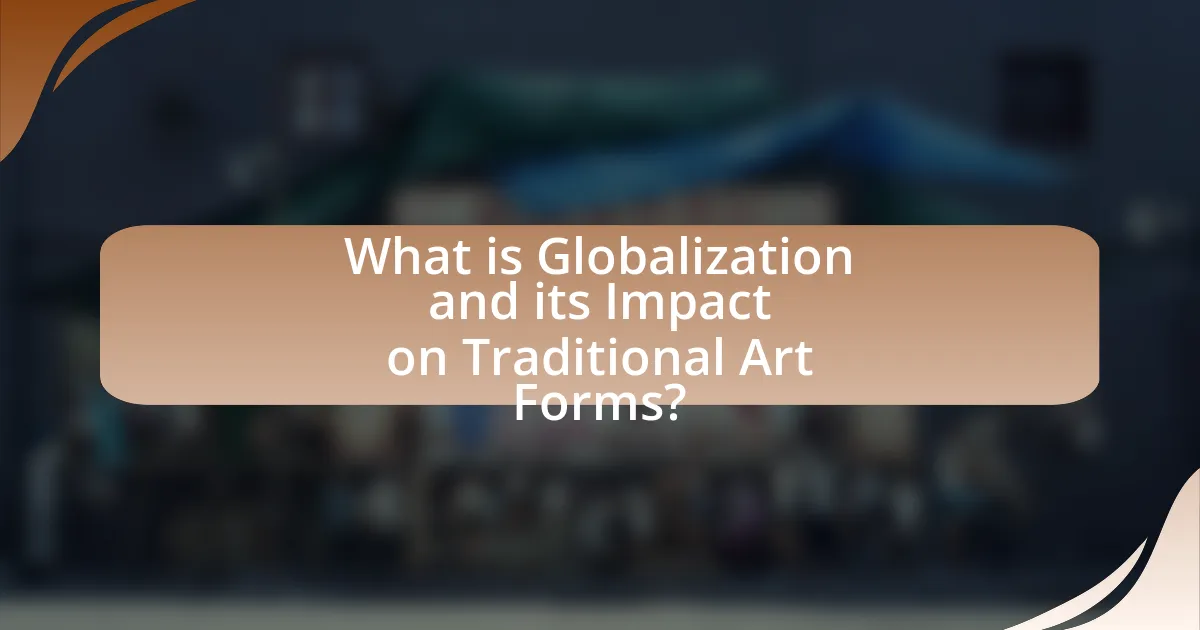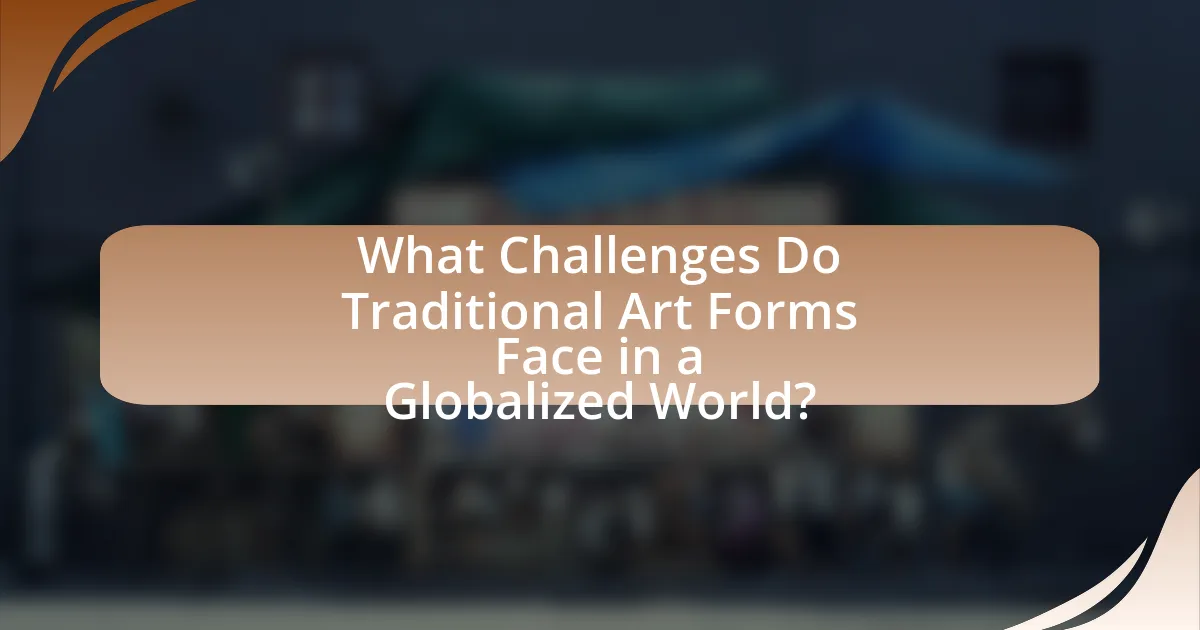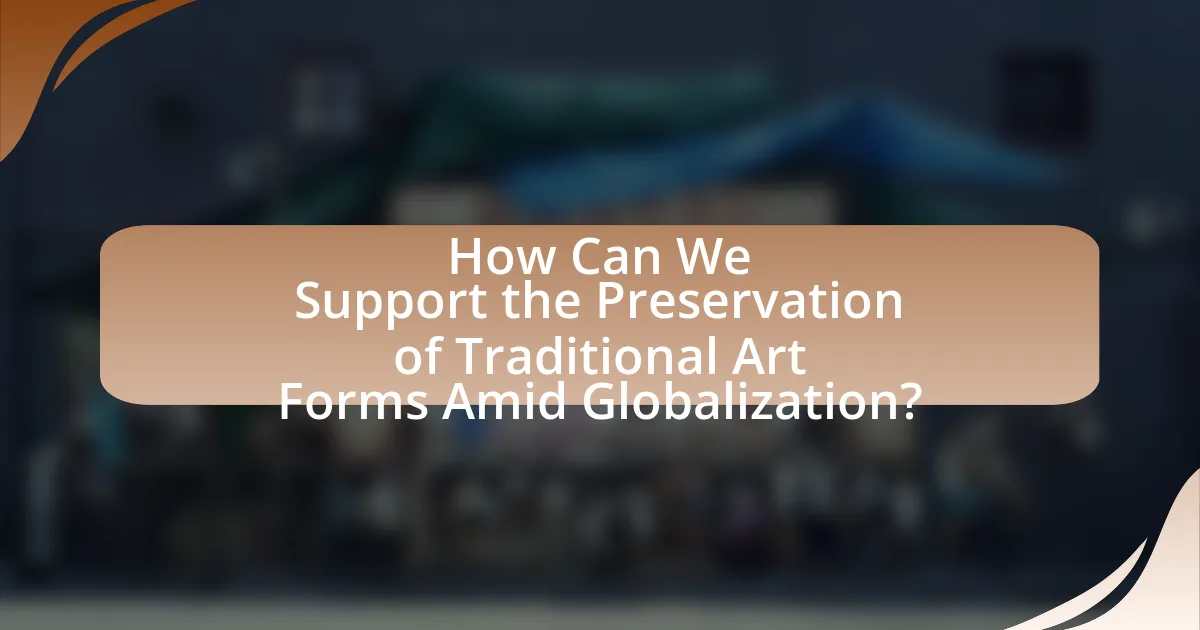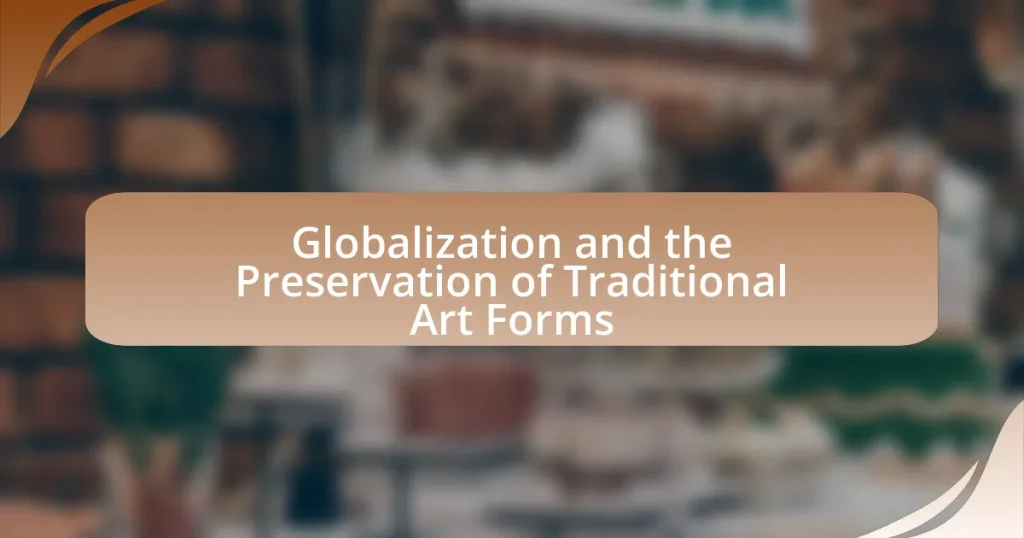Globalization refers to the increasing interconnectedness and interdependence among countries, significantly impacting traditional art forms. This article examines how globalization influences cultural exchange, leading to both the dilution of traditional art and opportunities for its revival through broader visibility. It discusses the mechanisms of cultural exchange, the challenges faced by traditional art forms, and the importance of preserving cultural identity and heritage. Additionally, it highlights the role of technology and education in supporting traditional artists and outlines practical steps individuals can take to promote and sustain these art forms in a globalized context.

What is Globalization and its Impact on Traditional Art Forms?
Globalization is the process of increased interconnectedness and interdependence among countries, primarily driven by trade, technology, and cultural exchange. Its impact on traditional art forms is significant, as it often leads to the dilution or transformation of these art forms due to the influx of global influences and commercial pressures. For instance, traditional crafts may adapt to meet the demands of a global market, resulting in a loss of authenticity and cultural significance. Research indicates that globalization can both threaten traditional art forms by promoting homogenization and simultaneously provide opportunities for their revival through increased visibility and access to broader audiences.
How does globalization influence cultural exchange?
Globalization significantly influences cultural exchange by facilitating the flow of ideas, practices, and artistic expressions across borders. This interconnectedness allows diverse cultures to interact, share, and adapt elements from one another, leading to hybrid forms of art and cultural practices. For instance, the rise of digital platforms enables artists from different backgrounds to collaborate and showcase their work globally, as seen in the fusion of traditional music styles with contemporary genres, which has gained popularity in various regions. Additionally, globalization can lead to the commercialization of traditional art forms, as seen in the global market for indigenous crafts, which can both promote and threaten the authenticity of these cultural expressions.
What are the mechanisms of cultural exchange in globalization?
Cultural exchange in globalization occurs through mechanisms such as migration, trade, technology, and media. Migration facilitates the movement of people and their cultural practices, leading to the blending of traditions and ideas. Trade introduces diverse cultural products and practices into new markets, allowing for cross-cultural interactions. Technology, particularly the internet and social media, enables rapid dissemination of cultural content, fostering global connections and exchanges. Media, including films, music, and literature, serves as a platform for sharing cultural narratives and experiences, influencing perceptions and practices across different societies. These mechanisms collectively contribute to the dynamic interplay of cultures in a globalized world.
How does cultural exchange affect traditional art forms?
Cultural exchange significantly influences traditional art forms by introducing new techniques, themes, and materials, which can lead to innovation and evolution within these art forms. For instance, the incorporation of Western artistic styles into traditional Asian painting has resulted in hybrid styles that maintain cultural significance while appealing to contemporary audiences. Historical examples include the impact of the Silk Road, where trade facilitated the exchange of artistic ideas between East and West, leading to the development of unique art styles that reflect a blend of cultural influences. This dynamic interaction often revitalizes traditional art, allowing it to adapt and remain relevant in a globalized context.
Why is the preservation of traditional art forms important?
The preservation of traditional art forms is important because it maintains cultural identity and heritage. Traditional art serves as a historical record, reflecting the values, beliefs, and practices of a community. For instance, UNESCO recognizes the significance of traditional art in fostering cultural diversity and promoting intercultural dialogue, as seen in its Convention for the Safeguarding of the Intangible Cultural Heritage. This preservation not only honors the past but also enriches contemporary society by providing a sense of belonging and continuity.
What role do traditional art forms play in cultural identity?
Traditional art forms are essential in shaping and expressing cultural identity. They serve as a medium through which communities convey their values, beliefs, and historical narratives. For instance, indigenous art often reflects the spiritual and social practices of a community, reinforcing a sense of belonging and continuity. Research indicates that traditional art forms, such as music, dance, and visual arts, contribute to cultural resilience by fostering intergenerational knowledge transfer, as seen in studies highlighting the role of Aboriginal art in Australia, which preserves stories and traditions that define their identity. Thus, traditional art forms are not merely aesthetic expressions; they are vital components of cultural identity that help maintain the uniqueness of communities in the face of globalization.
How do traditional art forms contribute to community cohesion?
Traditional art forms contribute to community cohesion by fostering shared cultural identity and facilitating social interactions among community members. These art forms, such as folk music, dance, and crafts, serve as a medium for storytelling and the transmission of cultural values, which strengthens communal bonds. For instance, community festivals that showcase traditional art encourage participation and collaboration, allowing individuals to connect over shared heritage. Research indicates that communities engaged in traditional art practices report higher levels of social trust and cooperation, as evidenced by a study published in the Journal of Community Psychology, which found that participation in cultural activities enhances social networks and community engagement.

What Challenges Do Traditional Art Forms Face in a Globalized World?
Traditional art forms face significant challenges in a globalized world, primarily due to cultural homogenization, economic pressures, and the loss of traditional knowledge. Cultural homogenization occurs as global media and popular culture overshadow local traditions, leading to a decline in the appreciation and practice of traditional art forms. Economic pressures arise when artists struggle to compete with mass-produced art and entertainment, often resulting in diminished funding and support for traditional practices. Additionally, the loss of traditional knowledge is exacerbated by urbanization and migration, which disrupt the transmission of skills and cultural heritage from one generation to the next. These factors collectively threaten the survival and authenticity of traditional art forms in an increasingly interconnected world.
How does commercialization threaten traditional art forms?
Commercialization threatens traditional art forms by prioritizing profit over cultural authenticity. This shift often leads to the commodification of art, where traditional practices are altered or diluted to appeal to mass markets, undermining their original significance and meaning. For instance, traditional crafts may be mass-produced, resulting in a loss of unique craftsmanship and cultural heritage. Additionally, the focus on commercial viability can marginalize artists who adhere to traditional methods, as they may struggle to compete with cheaper, mass-produced alternatives. This trend has been observed in various cultures, where traditional art forms are at risk of extinction due to the overwhelming influence of commercial interests.
What are the effects of mass production on traditional craftsmanship?
Mass production significantly undermines traditional craftsmanship by prioritizing efficiency and uniformity over artisanal skill and uniqueness. This shift leads to a decline in the demand for handcrafted goods, as consumers increasingly favor cheaper, mass-produced alternatives. For instance, the rise of fast fashion has resulted in a 20% decrease in the market for handmade textiles in regions known for their traditional weaving techniques. Consequently, artisans face economic pressures that can lead to the loss of cultural heritage and craftsmanship skills, as younger generations may opt for more stable employment in mass production industries rather than continuing traditional practices.
How does the demand for global art trends impact local traditions?
The demand for global art trends significantly impacts local traditions by often leading to their dilution or transformation. As artists and communities adopt global styles to appeal to broader markets, traditional techniques and themes may be overshadowed or altered, resulting in a loss of cultural authenticity. For instance, the rise of street art globally has influenced local muralists to incorporate contemporary elements, which can detract from the original cultural narratives embedded in traditional art forms. This phenomenon is documented in studies such as “Globalization and Its Impact on Local Art Forms” by Smith and Jones, which highlights how local artists adapt their practices in response to international trends, sometimes at the expense of their cultural heritage.
What role does technology play in the preservation of traditional art forms?
Technology plays a crucial role in the preservation of traditional art forms by enabling documentation, digitization, and wider accessibility. Through digital archiving, traditional artworks can be recorded in high resolution, ensuring that details are preserved for future generations. For instance, projects like the Google Arts & Culture initiative have digitized thousands of artworks, allowing global access and appreciation. Additionally, technologies such as 3D printing and virtual reality provide innovative ways to recreate and experience traditional art forms, further enhancing their preservation and relevance in contemporary culture. These technological advancements not only safeguard traditional art but also promote cultural exchange and education, reinforcing the importance of these art forms in a globalized world.
How can digital platforms support traditional artists?
Digital platforms can support traditional artists by providing them with a global audience and facilitating the sale of their work. These platforms, such as social media and online marketplaces, enable artists to showcase their creations to a wider demographic, breaking geographical barriers. For instance, platforms like Etsy and Instagram allow artists to reach potential buyers worldwide, increasing their visibility and sales opportunities. According to a report by the National Endowment for the Arts, artists who utilize online platforms can experience a significant increase in income, with many reporting sales growth of over 30% after establishing an online presence. This demonstrates that digital platforms not only enhance exposure but also contribute to the financial sustainability of traditional artists.
What are the risks of technology overshadowing traditional methods?
The risks of technology overshadowing traditional methods include the potential loss of cultural heritage and craftsmanship. As technology advances, there is a tendency for societies to prioritize efficiency and mass production over the unique qualities of traditional art forms. This shift can lead to the erosion of skills passed down through generations, as seen in the decline of handwoven textiles in favor of machine-made alternatives. Furthermore, reliance on technology may result in homogenization of artistic expressions, diminishing the diversity that traditional methods offer. Studies indicate that communities that embrace technology without preserving their traditional practices often experience a disconnect from their cultural identity, which can have long-term implications for social cohesion and cultural continuity.

How Can We Support the Preservation of Traditional Art Forms Amid Globalization?
Supporting the preservation of traditional art forms amid globalization can be achieved through targeted initiatives such as funding cultural programs, promoting local artisans, and integrating traditional arts into educational curricula. For instance, governments and organizations can allocate grants specifically for the documentation and revitalization of traditional crafts, which has been shown to enhance community engagement and sustain cultural heritage. Additionally, platforms that showcase local artists and their work can increase visibility and demand for traditional art, as evidenced by the success of initiatives like the UNESCO Intangible Cultural Heritage program, which recognizes and supports traditional practices globally. By fostering an environment that values and promotes traditional art, we can mitigate the homogenizing effects of globalization.
What strategies can be implemented to promote traditional art forms?
To promote traditional art forms, strategies such as community engagement, educational programs, and digital platforms can be implemented. Community engagement involves organizing local events and workshops that showcase traditional art, allowing artists to connect with audiences and share their skills. Educational programs in schools can incorporate traditional art into the curriculum, fostering appreciation among younger generations. Additionally, utilizing digital platforms, such as social media and online galleries, can broaden the reach of traditional art, making it accessible to a global audience. For instance, UNESCO has recognized the importance of digital archiving in preserving cultural heritage, highlighting how technology can support the visibility and sustainability of traditional art forms.
How can education play a role in preserving traditional art?
Education can play a crucial role in preserving traditional art by providing structured learning opportunities that promote awareness and appreciation of cultural heritage. Through formal education programs, students can learn about the history, techniques, and significance of traditional art forms, which fosters a sense of identity and continuity. For instance, art schools and community workshops often include curricula that focus on indigenous art practices, ensuring that these skills are passed down to future generations. Research indicates that educational initiatives, such as the UNESCO Convention on the Safeguarding of the Intangible Cultural Heritage, emphasize the importance of education in maintaining cultural expressions, thereby validating the role of education in this preservation effort.
What initiatives can governments and organizations take to support artists?
Governments and organizations can support artists by providing grants, funding programs, and tax incentives specifically aimed at creative projects. For instance, the National Endowment for the Arts in the United States allocates millions annually to support artists and arts organizations, fostering cultural development and preservation. Additionally, initiatives such as artist residencies and public art programs can enhance visibility and accessibility of traditional art forms, ensuring they thrive in a globalized context. These measures not only financially assist artists but also promote cultural heritage, as evidenced by the success of similar programs in countries like Canada and Australia, which have seen increased engagement in traditional arts through government support.
What are some successful examples of traditional art preservation?
Successful examples of traditional art preservation include the UNESCO World Heritage designation, which has protected numerous cultural sites and practices globally. For instance, the preservation of the traditional art of Japanese Noh theater has been supported through government funding and community initiatives, ensuring its continuation and transmission to future generations. Additionally, the revitalization of Indigenous Australian art forms, such as dot painting, has been achieved through educational programs and cultural festivals that promote awareness and appreciation of these traditions. These efforts demonstrate effective strategies in safeguarding traditional art against the pressures of globalization.
How have communities successfully integrated traditional art into modern contexts?
Communities have successfully integrated traditional art into modern contexts by utilizing contemporary platforms and technologies to showcase and promote their cultural heritage. For example, Indigenous artists in Canada have embraced digital media to share traditional storytelling and visual art, reaching wider audiences through social media and online galleries. This integration not only preserves their cultural identity but also fosters cross-cultural dialogue, as seen in initiatives like the “Indigenous Fashion Week” in Toronto, which combines traditional designs with modern fashion trends, attracting both local and international attention. Such efforts demonstrate the effectiveness of blending traditional art forms with modern practices to ensure their relevance and sustainability in today’s globalized world.
What lessons can be learned from successful preservation efforts?
Successful preservation efforts demonstrate the importance of community involvement and cultural sensitivity. Engaging local communities ensures that preservation initiatives are relevant and supported, as seen in the revitalization of traditional crafts in Japan, where artisans collaborated with local governments to maintain cultural practices. Additionally, successful efforts highlight the need for adaptive strategies that incorporate modern technology while respecting traditional methods, exemplified by the use of digital archiving in preserving indigenous languages. These approaches not only safeguard cultural heritage but also foster a sense of identity and continuity within communities.
What practical steps can individuals take to support traditional art forms?
Individuals can support traditional art forms by actively participating in and promoting local cultural events and workshops. Engaging in these activities helps to sustain the practices and skills associated with traditional arts, which are often at risk due to globalization. For instance, attending festivals that showcase traditional crafts or performances not only provides financial support to artists but also raises awareness about their cultural significance. Additionally, purchasing handmade items directly from artisans ensures that the economic benefits remain within the community, thereby fostering the continuation of these art forms. Research indicates that local economies thrive when traditional arts are supported, as seen in studies highlighting the positive impact of cultural tourism on artisan communities.










